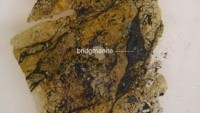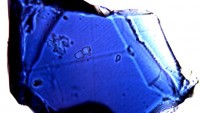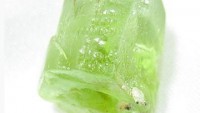‘Alien’ Organisms Might Exist in the Vast ‘Ocean’ 1,000 km Underground
| Arthur Dominic Villasanta | | Nov 30, 2016 08:14 PM EST |
Sample of a ringwoodite crystal thought to hold much of the Earth's sub-surface water.
Vast species of unknown microorganisms so unusual they can be called "alien" might dwell in a huge "ocean" that lies from 400 km to 1,000 km beneath the Earth's surface.
This eerie subterranean "ocean" isn't an ocean in the normal sense of an immense body of water, but it does contain more water than all the oceans and other bodies of water combined.
Like Us on Facebook
The incredibly vast reservoir of subterranean water is trapped inside massive layers of a special type of sponge-like rock called "ringwoodite."
Scientists have long suspected a "transition zone" in the Earth's mantle might be rich in water trapped in rare minerals such as ringwoodite. This transition zone lies between the upper and lower mantle layers 410 kilometers to 660 kilometers below the surface.
New evidence suggests this ocean might be found as deep as 1,000 km underground.
Direct evidence for water trapped in minerals was confirmed for the first time in 2014. A few weeks ago, however, more proof in the form of a diamond formed by intense water pressure deep underground was presented as proof there are immense stores of water stored in rocks.
Steve Jacobsen from Northwestern University in Illinois argues the Earth's mantle might contain several oceans' worth of water.
An Associate Professor of Earth and Planetary Sciences, Jacobsen studies the fundamental role of material properties in various aspects of Earth, planetary, and materials sciences. He's especially interested in the origin and distribution of water in the Earth.
The diamond found in Brazil has an imperfection (or a pocket called an "inclusion") containing minerals trapped during the diamond's formation. Researchers found unmistakable evidence for the presence of hydroxyl ions that normally comes from water.
"Based on the composition of the trapped mineral, we speculate that the depth (it formed) was around 1,000 kilometers," said Jacobsen.
Since the inclusion was trapped in the diamond the whole time, the water signature can only have come from the diamond's place of formation in the lower mantle.
"This is the deepest evidence for water recycling on the planet," he said. "The big take-home message is that the water cycle on Earth is bigger than we ever thought, extending into the deep mantle."
There is speculation these deep layers of water-rich rock might harbor microorganisms that have adapted to the immense pressures and heat generated this deep into the Earth. These "aliens" microorganisms might be as robust as those that live and thrive along volcanic vents in crushing ocean depths.
One of these extremophiles, a single-celled organism called Geogemma barossii, thrives near deep-sea hydrothermal vents off the northwest U.S. coast in temperatures of up to 248 degrees Fahrenheit -- a feat many scientists believed was impossible.
Other scientists believe extremophiles can even exist in the "biotic fringe" close the Earth's core. This fringe is described as a "boundary where current knowledge predicts that no living cells persist" because the temperature and pressures are too high.
Previous to these new discoveries, scientists in the U.S. conducted experiments on ringwoodite, a water-rich mineral, by analyzing seismic waves travelling through the mantle beneath the US. They discovered that downward-flowing mantle material was melting as it crossed the boundary between the transition zone and the lower mantle layer.
This led researchers to conclude there has to be water in the transition zone because of this melting. Melting is a way of getting rid of water, which is unstable under conditions in the Earth's lower mantle, said researchers.
A study published 2014 in the journal Science said the transition zone "... can hold a lot of water, and could potentially have the same amount of H2O (water) as all the world's oceans."
Most of this water in this sub-surface "ocean" is trapped inside ringwoodite. This is a rare type of mineral that forms from a mineral called olivine under very high pressures and temperatures such as those present in the mantle's transition zone.
Olivine, also called peridot or chrysolite, is a magnesium iron silicate mineral common in the Earth's sub-surface.
Scientific studies have shown that ringwoodite can contain water. This water isn't present as liquid, ice or vapor, however.
Instead, the water is trapped in the ringwoodite's molecular structure as hydroxide ions or bonded oxygen and hydrogen atoms.
Scientists have previously used many approaches to look for evidence of Earth's interior water reservoir. This is the first time scientists have searched for clues of the reservoir by focusing on the potential water-induced melting at the bottom of the transition zone.
The new findings will help scientists better understand Earth's water cycle. Scientists know that the surface water we now have comes from degassing of molten rock. It came from the original rock ingredients in the Earth. The question now facing scientists is how much water is still inside the Earth today relative to the surface.
Tagssubterranean ocean, Earth, mantle, ringwoodite, transition zone, Steve Jacobsen, Northwestern University
©2015 Chinatopix All rights reserved. Do not reproduce without permission
EDITOR'S PICKS
-

Did the Trump administration just announce plans for a trade war with ‘hostile’ China and Russia?
-

US Senate passes Taiwan travel bill slammed by China
-

As Yan Sihong’s family grieves, here are other Chinese students who went missing abroad. Some have never been found
-

Beijing blasts Western critics who ‘smear China’ with the term sharp power
-

China Envoy Seeks to Defuse Tensions With U.S. as a Trade War Brews
-

Singapore's Deputy PM Provides Bitcoin Vote of Confidence Amid China's Blanket Bans
-

China warns investors over risks in overseas virtual currency trading
-

Chinese government most trustworthy: survey
-

Kashima Antlers On Course For Back-To-Back Titles
MOST POPULAR
LATEST NEWS
Zhou Yongkang: China's Former Security Chief Sentenced to Life in Prison

China's former Chief of the Ministry of Public Security, Zhou Yongkang, has been given a life sentence after he was found guilty of abusing his office, bribery and deliberately ... Full Article
TRENDING STORY

China Pork Prices Expected to Stabilize As The Supplies Recover

Elephone P9000 Smartphone is now on Sale on Amazon India

There's a Big Chance Cliffhangers Won't Still Be Resolved When Grey's Anatomy Season 13 Returns

Supreme Court Ruled on Samsung vs Apple Dispute for Patent Infringement

Microsoft Surface Pro 5 Rumors and Release Date: What is the Latest?













